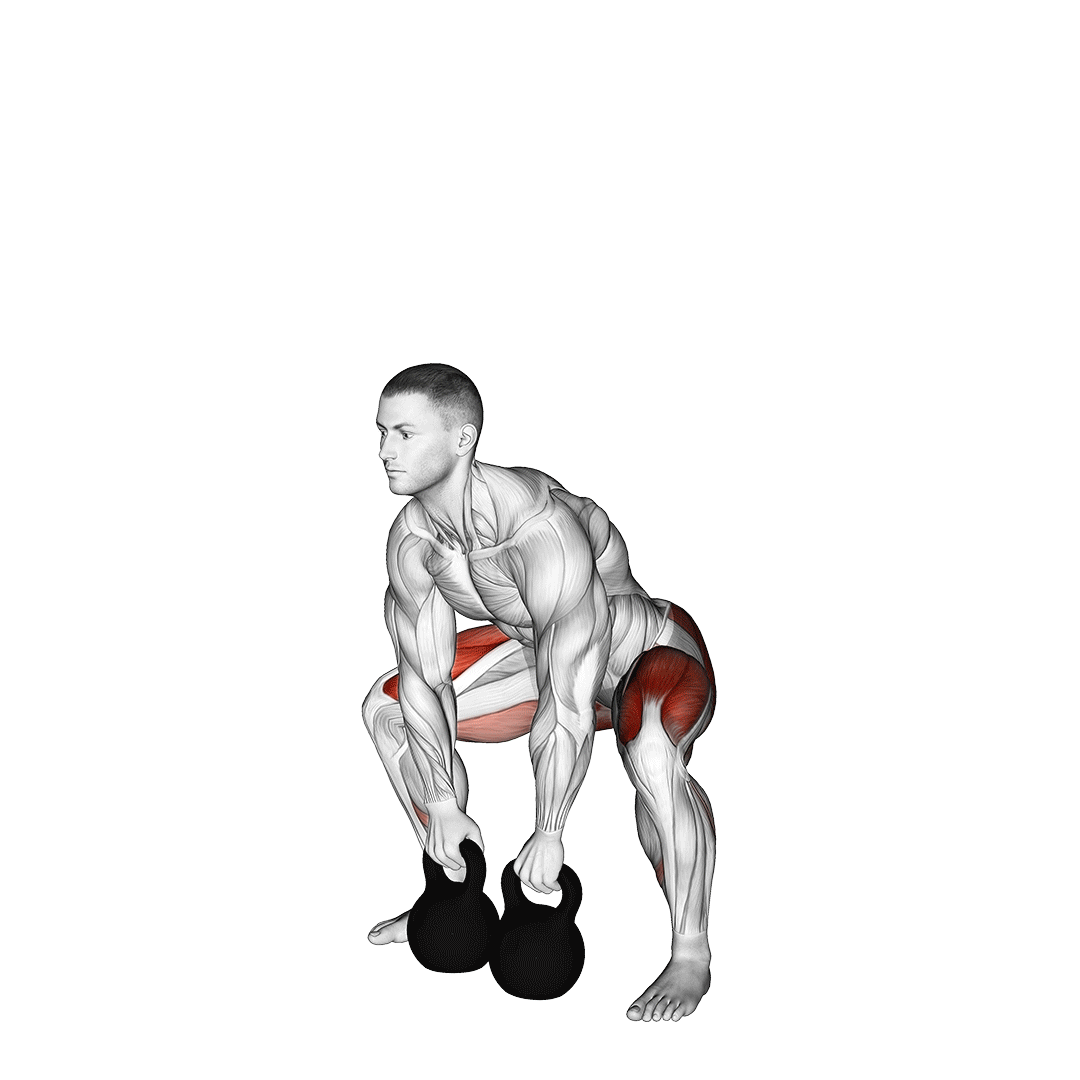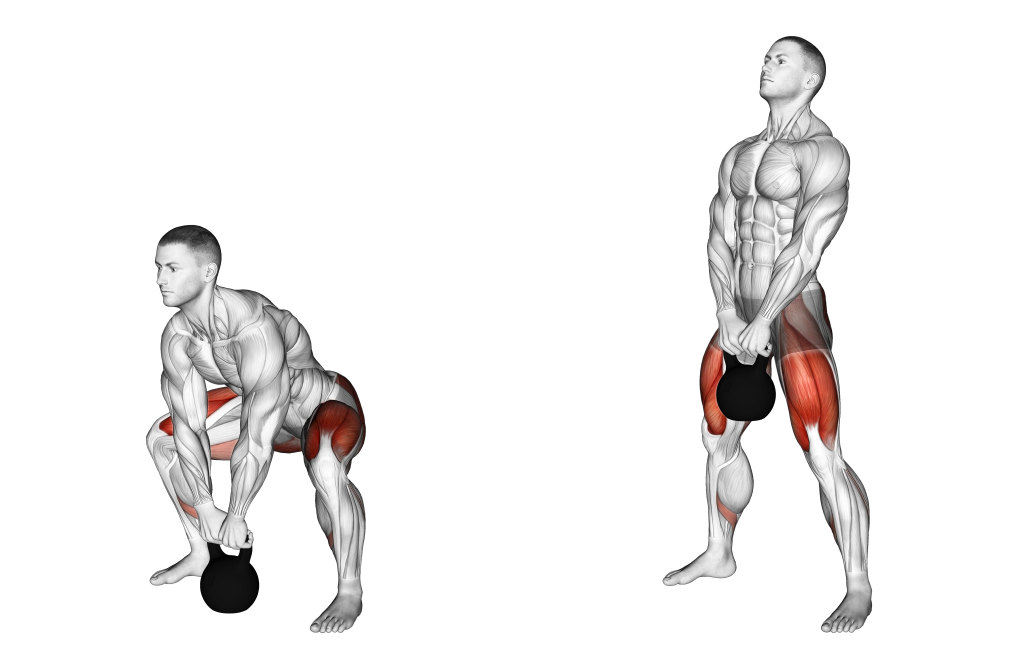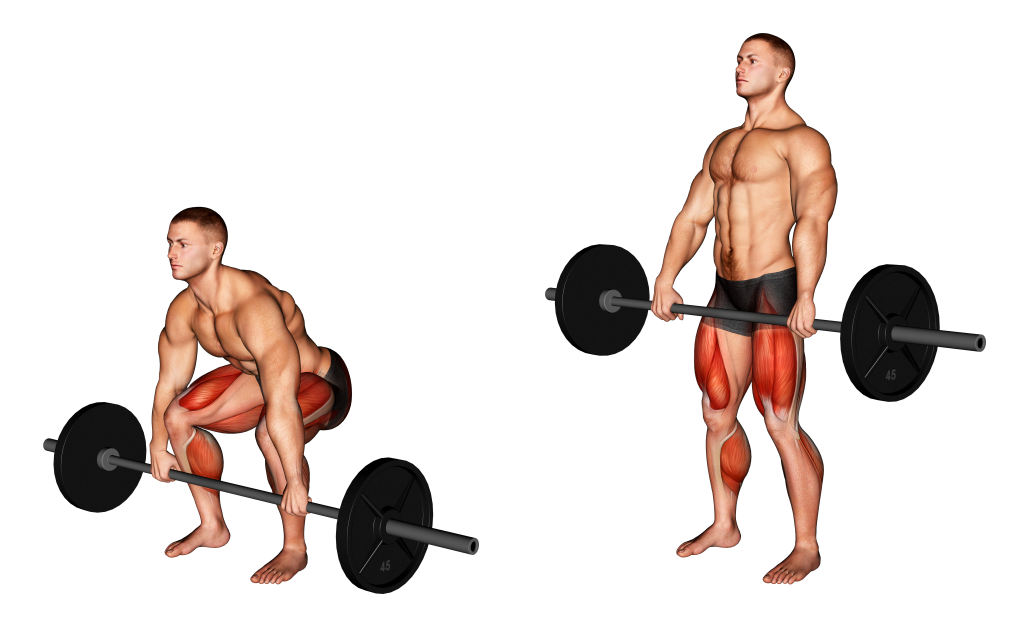Kettlebell Sumo Deadlift: Benefits, Muscles Worked, and More
The kettlebell sumo deadlift is a multi-joint free weight compound exercise with a particular focus on the posterior chain muscles, though it is capable of recruiting practically every muscle group throughout the body to a certain extent.

The kettlebell sumo deadlift is most frequently encountered as a primary compound exercise in athletic training programs, or otherwise as a substitute to the standard barbell sumo deadlift in more traditional strength training programs.
Who Should Perform the Kettlebell Sumo Deadlift?
The kettlebell sumo deadlift is somewhat lower impact than a barbell sumo deadlift, and as such is accessible to even novice lifters or those who are unfamiliar with conventional deadlift mechanics.
However, it excels the most at aiding athletes and powerlifters in developing posterior chain power and explosiveness.
What Equipment Does the Kettlebell Sumo Deadlift Need?
The kettlebell sumo deadlift requires only a single moderate or heavy weight kettlebell.
How to Do the Kettlebell Sumo Deadlift
In order to perform a repetition of the kettlebell sumo deadlift, the lifter will stand upright with their feet set wider than hip-width apart and a kettlebell resting between their feet.
Flexing the core and ensuring that the spine in kept in a neutral curvature, the lifter will then bend at the hips and knees simultaneously, gripping the kettlebell with both hands as it comes within reach.
Maintaining their hold on the kettlebell, the lifter will then exert force through their heels as they straighten the hips and knees, pushing the chest outwards as their torso returns to a vertical position.
Once the knees and hips are in a state of full extension, the lifter will hold the apex position for a moment before releasing the kettlebell, thereby completing the repetition.
Keep in mind that this is a sumo deadlift and not a conventional deadlift, meaning that the width of the lifter’s stance will be wider than in other deadlift variations, and that the arms go between the legs, rather than on the outside.
What Muscles are Worked by the Kettlebell Sumo Deadlift?
As a compound exercise, the kettlebell sumo deadlift is capable of recruiting a wide variety of muscle groups across the entire body, with those recruited to the greatest extent (and therefore receiving the most benefits) being dubbed the primary mover muscles, and other muscle groups worked to a lesser extent being called the secondary mover muscles or stabilizing muscles.

Primary Mover Muscles
The main muscle groups utilized during a repetition of the kettlebell sumo deadlift are; the glutes, hamstrings, quadriceps and hip flexors - though the erector spinae may also play some small dynamic role as well.
Secondary Mover Muscles and Stabilizers
Other muscle groups that act in a supportive or stabilizing capacity during the kettlebell sumo deadlift are; the entirety of the core, the deltoids, the trapezius, the erector spinae (again) and the calves - all of which are either recruited in an isometric manner or otherwise in a small range of motion.
What are the Benefits of Doing Kettlebell Sumo Deadlifts?
Apart from the sort of benefits that are received from resistance training in general, the kettlebell sumo deadlift is also capable of imparting certain positive effects that are unlikely to be gained from other exercises.
Power and Explosiveness Development
Like all other deadlift variants, the kettlebell sumo deadlift is a particularly useful tool for developing a lifter’s lower body power and general explosiveness.
This sort of development is achieved by the kettlebell sumo deadlift’s targeting of the posterior chain - of which is responsible for much of the lower body’s power - as well as the fact that it is a wide-reaching compound movement of significant intensity, replicating the sort of muscular recruitment that explosive physical activities will require.
Carryover and Progression to Other Deadlift Variations
The kettlebell sumo deadlift is sufficiently low-impact enough to act as an introduction to heavier deadlift variations, allowing novice lifters or athletes returning from physical rehabilitation to work their way towards exercises like the conventional barbell deadlift or Romanian deadlift.

While this isn’t to say that the kettlebell sumo deadlift is inherently inferior to other deadlift exercises, it can nonetheless help keep the pace of a lifter’s progression by allowing for more weight to be lifted with a different exercise.
Low Equipment Requirement
The kettlebell sumo deadlift is particularly useful for home gym owners or individuals without access to a barbell and set of plates, as it only requires a single moderate-to-heavy kettlebell.
While this does mean that progressive overload through increasing the weight is going to be difficult, it is perfect for a temporary alternative to barbell-based deadlift variations.
More Natural Movement Pattern
Though many of the same mechanics of the sumo deadlift are present in the kettlebell sumo deadlift, the usage of a smaller source of resistance and placing the hands closer together can provide a more advantageous movement overall.
This, in turn, helps reduce the risk of injury that deadlifts are infamous for, and can allow lifters with poor wrist or shoulder mobility to perform deadlifts without irritating their joints.
Full Lower Body and Core Recruitment
Much like other deadlift variations, the kettlebell sumo deadlift is capable of efficiently recruiting the entirety of the lower body alongside the core musculature.
Muscular growth in these areas can directly carryover to a number of non-weightlifting related activities, such as sprinting or jumping, not to mention the greatly reduced risk of future injury from strengthening of the core’s various muscles.
Common Mistakes of the Kettlebell Sumo Deadlift
Though the kettlebell sumo deadlift is as simple as a deadlift variation can get, there are still several common mistakes that even the more advanced weightlifter can make - all of which should be corrected as soon as possible so as to prevent any injuries from occurring.
Squatting Downwards
Lifters unfamiliar with conventional deadlifts may be tempted to squat downwards before performing the initial pull of the exercise - a mistake, as squatting downwards will lower the pelvis too far and reduce the involvement of the upper body in the process.
In order to perform the kettlebell sumo deadlift properly, it is important for the lifter to utilize a hip hinge, rather than lowering themselves as if performing a squatting movement.
Rounding of the Lower Back
Just as is the case in all deadlift variations, failing to maintain proper spinal curvature by allowing the lower back to round at any point during the exercise can lead to injuries and generally poor performance.
It is absolutely vital to ensure that the lower back is in a neutral curvature throughout each repetition of the kettlebell sumo deadlift, and that the core musculature is appropriately braced so as to support this lower back neutrality.
Lifters with trouble maintaining a core brace or without the requisite coordination to maintain a neutral lower back should practice with a light weight kettlebell until they are more familiar with the form cue.
Retracting the Scapula
Retracting the scapula is another common mistake made when performing the sumo deadlift, regardless of whether it is with a kettlebell or otherwise.
The reason why retracting the shoulder blades is generally seen as a mistake is because it will shorten the distance that the arms can extend, thereby forcing the lifter to lower themselves further during the initial pull and overall creating a weaker deadlift.
This is especially true for the kettlebell sumo deadlift, which requires a somewhat lengthier arm extension due to the smaller handle of a kettlebell.
Uneven Joint Movement
Descending with either the hips or knees first can place excessive stress on either set of joints, leading to injuries and irritation over the long term.
For the smoothest and most efficient movement, it is best to bend at both the hips and knees simultaneously, especially when performing exercises with significant weight like the kettlebell sumo deadlift.
Frequently Asked Questions (FAQ)
What is the Difference Between a Kettlebell Sumo Deadlift and Deadlifts?
The kettlebell sumo deadlift has a greater capacity to recruit the muscles of the quadriceps femoris than the conventional deadlift - a distinction made possible by the somewhat wider and more forward stance of the sumo deadlift.
Furthermore, this same stance allows for a greater amount of weight to be lifted, as well as produces a more advantageous position for lifters with bodily proportions of shorter arms and longer legs.
Are Kettlebell Deadlifts Effective?
Yes - kettlebell deadlifts are quite effective, especially at building the strength and size of the posterior chain.
Apart from simple muscular hypertrophy, they are also an excellent tool for developing the power and explosiveness of the entire body - making the kettlebell deadlift an invaluable exercise for any athletic training program, regardless of whether it is the sumo or conventional variation.
How Heavy Should a Kettlebell Deadlift be?
Though kettlebell deadlifts are still deadlifts and as such are meant to be performed with heavy weight, the usage of a kettlebell means that less total weight will be lifted per repetition, especially in comparison to barbell-based deadlift variations.
Generally, lifters will want to lift an amount of weight that allows an RPE of 9 despite a moderate amount of volume per set.
References
1. Meigh, N.J., Keogh, J.W.L., Schram, B. et al. Effects of supervised high-intensity hardstyle kettlebell training on grip strength and health-related physical fitness in insufficiently active older adults: the BELL pragmatic controlled trial. BMC Geriatr 22, 354 (2022). https://doi.org/10.1186/s12877-022-02958-z
2. Meigh NJ, Keogh JWL, Schram B, Hing WA. Kettlebell training in clinical practice: a scoping review. BMC Sports Sci Med Rehabil. 2019 Sep 3;11:19. doi: 10.1186/s13102-019-0130-z. PMID: 31497302; PMCID: PMC6719359.

